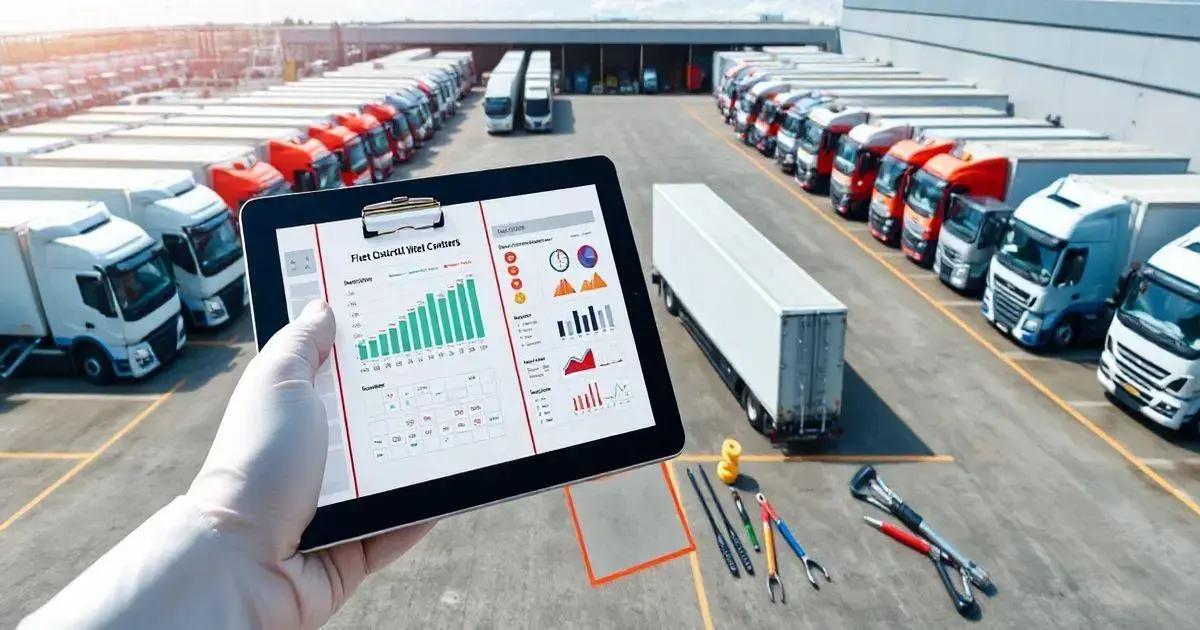Top 5 Fleet Control Worksheet Benefits for Efficient Management Leave a comment
The Fleet Control Worksheet 7.0 is an essential tool for fleet management that helps monitor vehicle performance, track maintenance, and manage costs through features like initial dashboards for key metrics, accurate record keeping, organized document management, travel control mechanisms for optimizing trips, and preventive maintenance techniques to enhance vehicle reliability.
A fleet control worksheet is an essential tool for businesses managing multiple vehicles. It streamlines maintenance tracking, vehicle performance analysis, and cost management, making it invaluable for efficient fleet operations.
This article explores the top benefits of using a fleet control worksheet, providing insights that can help optimize your vehicle management strategy.
Initial Dashboards Overview
The Initial Dashboards of the Fleet Control Worksheet 7.0 provide a comprehensive overview of key performance indicators that are crucial for effective fleet management. These dashboards are designed to give fleet managers quick insights into vehicle performance, driver efficiency, and maintenance needs.
Here are some crucial components included in the Initial Dashboards:
- KM by Driver: Tracks the total kilometers driven by each driver, helping to evaluate their activity levels and performance.
- KM per Vehicle: Monitors the distance traveled by each vehicle, allowing for better assessment of usage and wear.
- KM per Liter: Calculates fuel efficiency, which is essential for managing fuel costs and identifying vehicles that may need maintenance.
- KM per Trip: Provides insights into the average distance covered for each trip, assisting in route planning and optimization.
- Average Consumption per Vehicle: Analyzes fuel consumption trends for each vehicle, helping to spot anomalies and areas for improvement.
These dashboard metrics not only facilitate better decision-making but also enhance overall operational efficiency. By keeping track of these indicators, fleet managers can proactively address issues, maintain optimal performance, and reduce costs associated with fuel and maintenance.

Record Keeping and Registrations
Effective record keeping and registrations are fundamental components of the Fleet Control Worksheet 7.0. This section is crucial for maintaining organized and accessible information regarding drivers and vehicles, which aids in compliance and operational efficiency.
Here are the key elements involved in record keeping and registrations:
- Driver Registration: This includes comprehensive details about each driver, such as their name, contact information, license number, and employment history. Keeping this information updated ensures that you have accurate records for compliance and safety purposes.
- Vehicle Type Registration: Documenting the specific types of vehicles in the fleet, including make, model, and year of manufacture. This information is vital for maintenance schedules and ensuring appropriate insurance coverage.
- Mechanical and Electrical Services Registry: A detailed log of all mechanical and electrical services performed on each vehicle, including dates, service types, and service providers. This helps in tracking the health of the fleet and planning future maintenance needs.
- Lubricant Services Register: An essential log that records lubricant services for each vehicle, detailing the types and quantities of lubricants used. Regular tracking helps ensure that vehicles run efficiently and reduces wear and tear.
- Fuel Type Register: Keeping track of the types of fuel used by each vehicle allows for better analysis of fuel consumption and costs, enabling more informed decisions about fuel purchases and usage.
Implementing a robust system for record keeping and registrations not only simplifies audits and compliance checks but also streamlines maintenance scheduling and performance evaluations. By keeping accurate and detailed records, fleet managers can enhance overall fleet management and ensure smooth operations.
Document Management Strategies
Effective document management is crucial for maintaining organized, accessible, and secure records related to fleet operations. The Fleet Control Worksheet 7.0 provides strategies to streamline document management processes, ensuring that all important documentation is handled efficiently.
Here are some essential document management strategies to implement:
- Driver Document Control: Establish a system to manage all documents related to drivers, such as licenses, certifications, and training records. This includes setting reminders for expiration dates to ensure compliance and avoid legal issues.
- Vehicle Document Control: Keep track of all documents pertaining to each vehicle, including registration, insurance, and maintenance records. Organizing these documents helps in quick retrieval during audits or inspections and ensures that all vehicles are compliant with regulations.
- Centralized Document Repository: Utilize a centralized digital platform where all documents can be stored and accessed easily. This ensures that everyone involved in fleet management has access to the latest information, reducing the risk of miscommunication.
- Document Version Control: Implement a version control system to manage changes and updates to important documents. This allows fleet managers to track revisions, ensuring that everyone is using the most current documents and reducing confusion.
- Regular Audits: Conduct regular audits of documents related to drivers and vehicles to ensure accuracy and compliance. Periodic reviews help identify gaps in documentation and provide opportunities for improvement.
By implementing these document management strategies, fleet managers can enhance operational efficiency, ensure compliance with regulations, and improve overall management of driver and vehicle documentation. A well-organized document management system can ultimately save time, reduce errors, and contribute to the overall success of fleet operations.

Travel Control Mechanisms
Implementing effective travel control mechanisms is key to managing a fleet successfully. The Fleet Control Worksheet 7.0 provides several tools that help ensure that all travel activities are monitored, managed, and optimized for efficiency.
Here are the essential travel control mechanisms included in the worksheet:
Travel Control Mechanisms
- Cargo Control Linked to Trips: This feature tracks the cargo associated with each trip, helping to ensure that all deliveries are accounted for and that cargo is handled appropriately. It enables fleet managers to evaluate the efficiency and reliability of deliveries.
- Vehicle Control: Monitoring the usage of each vehicle during its trips is crucial. Keeping records of when and where vehicles are used can highlight patterns of use and help identify vehicles that may require additional maintenance or are underutilized.
- Driver Control: Keeping track of driver performance during trips allows fleet managers to evaluate driver efficiency and adherence to safety protocols. Monitoring driver behavior can help in providing targeted training and improving overall safety.
- Supply Control: This mechanism ensures that all supplies related to travel—such as fuel, maintenance supplies, and cargo materials—are adequately managed. Having a clear overview of supply levels helps prevent shortages and ensures that vehicles are always ready for trips.
- Control of All Travel Expenses: Detailed tracking of all associated travel expenses—including fuel costs, tolls, and maintenance—allows fleet managers to analyze the total cost of trips. This information is crucial for budgeting and identifying areas where savings may be achieved.
By leveraging these travel control mechanisms, fleet managers can enhance the efficiency of their operations, reduce costs, and improve the overall performance of their fleet. A comprehensive approach to travel control not only ensures accountability but also supports strategic decision-making regarding routes, vehicle usage, and driver performance.
Maintenance Control Techniques
Effective maintenance control is vital for ensuring the longevity and reliability of your fleet. The Fleet Control Worksheet 7.0 incorporates various maintenance control techniques designed to help fleet managers stay ahead of repairs and upkeep, keeping vehicles in optimal working condition.
Here are some essential maintenance control techniques included in the worksheet:
- Corrective and Preventive Maintenance Types: This includes differentiating between corrective maintenance (repairs made after a breakdown) and preventive maintenance (scheduled services designed to prevent breakdowns). Maintaining a calendar for both types ensures that vehicles receive necessary care before issues arise.
- Maintenance by Vehicle: Tracking maintenance requirements for each vehicle individually allows fleet managers to tailor schedules based on usage and specific needs, ensuring that every vehicle receives appropriate attention without unnecessary downtime.
- Maintenance by Mechanical and Electrical Type: Categorizing maintenance tasks by mechanical and electrical issues simplifies the tracking and scheduling of repairs. This technique helps prioritize maintenance efforts and allocate resources more effectively.
- Maintenance Cost Tracking: Keeping detailed records of all maintenance costs associated with each vehicle allows for better budgeting and helps identify trends in vehicle maintenance expenses. Analyzing this data can lead to better purchasing decisions regarding future vehicles or parts.
- Preventive Maintenance Schedule: Setting up a preventive maintenance schedule based on mileage, time, or usage metrics helps ensure that vehicles are serviced regularly. This proactive approach minimizes the risk of unexpected breakdowns and extends the lifespan of the fleet.
- Preventive Maintenance Signal: Utilizing alerts or signals within the worksheet helps remind fleet managers when a vehicle is due for preventive maintenance. This ensures that no scheduled services are overlooked, keeping the fleet operating smoothly.
- Status by: Scheduled, Accomplished, and Delayed: Monitoring the status of maintenance tasks helps in evaluating the effectiveness of the maintenance program. By categorizing tasks as scheduled, accomplished, or delayed, managers can quickly identify areas needing attention and take action before they become urgent issues.
By integrating these maintenance control techniques, fleet managers can effectively minimize vehicle downtime, reduce operational costs, and enhance the overall reliability of their fleet. A strategic approach to maintenance ensures not only safety and efficiency but also strengthens the long-term investment in fleet assets.
Conclusion
In summary, the Fleet Control Worksheet 7.0 is an invaluable tool for fleet managers aiming to streamline operations and enhance efficiency.
By implementing effective initial dashboards, robust record-keeping strategies, comprehensive document management, and thorough travel and maintenance control mechanisms, businesses can significantly improve their fleet management practices.
These strategies not only provide insights into vehicle performance and driver efficiency but also help in managing costs and ensuring compliance with regulations.
Ultimately, investing in such systematic approaches will lead to better decision-making, increased vehicle longevity, and enhanced overall productivity.
As fleets continue to evolve in complexity, utilizing the right tools and techniques will be key to staying ahead in the competitive landscape.
Embracing the Fleet Control Worksheet 7.0 will undoubtedly set the foundation for successful fleet management and operational excellence.
FAQ – Frequently Asked Questions about Fleet Control Worksheet 7.0
What is the Fleet Control Worksheet 7.0?
The Fleet Control Worksheet 7.0 is a comprehensive tool designed for fleet managers to track vehicle usage, maintenance, driver performance, and related expenses, enhancing overall fleet management efficiency.
How can I use the Initial Dashboards?
The Initial Dashboards provide key performance indicators, such as KM by Driver and KM per Vehicle, which help you monitor and analyze the performance of your fleet at a glance.
What types of record-keeping are included?
Record-keeping includes Driver Registration, Vehicle Type Registration, and logs for Mechanical and Electrical Services, ensuring that all critical information is organized and accessible.
What are the key document management strategies?
Key strategies include Driver Document Control, Vehicle Document Control, and maintaining a centralized digital repository for easy access to all relevant documents.
How do travel control mechanisms improve fleet efficiency?
Travel control mechanisms track cargo, vehicle, and driver usage, enabling better planning, cost management, and ensuring that all trips are accounted for and optimized.
Why are maintenance control techniques important?
Maintenance control techniques are essential for proactively managing vehicle upkeep, minimizing downtime, and reducing repair costs by scheduling regular preventive maintenance.

